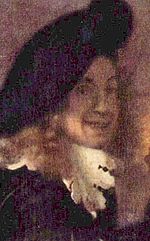
The life and art of Johannes Vermeer are closely associated with the city of Delft. Vermeer was born in Delft in 1632 and lived there until his death in 1675. His father, Reynier Jansz., was a weaver who produced "caffa," a fine satin fabric. In 1631 he also registered in the Saint Luke's Guild in Delft as a master art dealer. By 1641 he was sufficiently prosperous to purchase a large house with an inn, the "Mechelen," on the market square in Delft, where he probably also sold paintings. When Reynier died in 1652 Johannes apparently inherited his father's business. By that time he must have already decided on a career as a painter. It is assumed that he trained in Delft, perhaps with Leonaert Bramer (1596-1674), who seems to have had close associations with Vermeer's family, or with Carel Fabritius (1622-1654). No documents, however, exist about his artistic training or apprenticeship, and he may have studied elsewhere, perhaps in Utrecht or Amsterdam.
Vermeer, who was baptized on 31 October 1632 in the Reformed Church in Delft, was raised a Protestant. In April 1653 Vermeer married into a Catholic family and seems to have converted to Catholicism shortly before that date to placate his future mother-in-law, Maria Thins. Maria Thins lived in the so-called Papists' Corner ("Papenhoek") of Delft, adjacent to one of the two churches where Catholics could worship, the Jesuit church on the Oude Langendijck. Vermeer and his wife, Catharina Bolnes, eventually moved from the "Mechelen" into her house. They named their first daughter Maria, in honor of Maria Thins, and their first son Ignatius, after the patron saint of the Jesuit Order.
Vermeer became a master in the Saint Luke's Guild on 29 December 1653. His aspiration at that time seems to have been to become a history painter, for his first works were large-scale mythological and religious paintings. Shortly thereafter he began to paint the genre scenes, landscapes, and allegories for which he has become renowned. While Vermeer's subject matter changed in the mid-1650s, he nevertheless continued to imbue his later works with the quiet, intimate moods of his early history paintings.
Although very little is known about relationships with other painters who might have influenced the thematic and stylistic direction of his art, Vermeer apparently knew Gerard ter Borch II, with whom he co-signed a document in 1653. Another artist who may well have had an impact on his work during the 1650s was Pieter de Hooch, who painted comparable scenes in Delft during that period. Vermeer remained a respected artist in Delft throughout the rest of his life. He was named hoofdman of the Delft St. Luke's Guild in 1662, 1663, 1670, and 1671.
Vermeer's few works--they number only about thirty-five--were not well known outside of Delft, perhaps because many of them were concentrated in the collection of a patron in Delft who seems to have had a special relationship with the artist. When Vermeer died, however, he was heavily in debt, in part because his art dealing business had suffered during the difficult economic times following the French invasion of the Netherlands in the early 1670s. Vermeer was survived by his wife Catharina and eleven children, eight of whom were underage. His wife petitioned for bankruptcy the following year. Antonie van Leeuwenhoek, the famed Delft microscopist who was apparently a friend of Vermeer, was named trustee for the estate.